Within days of their Dec. 7, 1941 surprise attack on Pearl Harbor, the Japanese Imperial Navy occupied scores of islands throughout the western Pacific Ocean. Japan’s goal was to create a defensive buffer against attack from the United States and its Allies – one that would ensure their mastery over East Asia and the Pacific. It wasn’t until the United States’ strategic victories at the Battles of the Coral Sea (May 4-8, 1942) and Midway (June 4-7, 1942) finally halted the Japanese Empire’s expansion that the Allies were free to unleash an offensive.
The strategically-located Solomon Island chain, lying to the east of Papua New Guinea and critical to protecting the supply lines between the U.S. and Australia, was selected as the place to begin the island-hopping offensive campaign to take the Pacific back from the Japanese. The Solomon Island operation, America’s first amphibious operation since 1898, lasted six months and consisted of a number of major battles – on land, at sea, and in the air.
American forces first landed on the Solomon Islands of Guadalcanal, Tulagi and Florida on the morning of August 7, 1942. It took some very fierce fighting, but the Marines cleared Tulagi and Florida in two days. The main American forces on Guadalcanal met little resistance on their way inland to secure the airfield at Lunga Point (later renamed Henderson Field). Almost immediately, Japanese naval aircraft attacked transport and escort ships, and Japanese reinforcements were sent to the area. The fight for control of Guadalcanal and the surrounding seas continued for months with no clear winner, while both sides continued to lose men, ships and aircraft.
It seemed that every time the U.S. achieved a hard-fought victory, the Japanese would resupply Guadalcanal by night via the infamous “Tokyo Express” fast destroyer resupply chain and be ready for more fighting the next day. But eventually, U.S. forces gained the upper hand, and by February 1943, after six months of deadly and costly combat, the Japanese withdrew the last of their men and conceded the island to the Allies.

Guadalcanal was also the Coast Guard’s first major participation in the Pacific Campaign. These men were assigned a vital role in the landings – the operation of amphibious-type assault craft. Many of the Coast Guard Coxswains (who are in charge of the navigation and steering of a boat) came from Life-Saving Stations, and their training and experience with small boats in treacherous waters close to shore made them the most-qualified small-boat handlers for the crucial task of landing fighting men on the beaches. One such boat handler was Douglas Munro.
Douglas Munro is a Hero of The Coast Guard
Douglas Albert Munro was born on October 11, 1919, in Vancouver, British Columbia, Canada. His father, James Munro, who originally hailed from California, and his mother, Edith Thrower Fairey from Liverpool, England, settled their small family of four in South Cle Elum, Washington, just outside of Seattle, where they raised young Douglas and his elder sister Pat. Douglas remained in South Cle Elum, from grade school through high school graduation in 1937, and then attended the Central Washington College of Education in nearby Ellensburg, Washington.
Munro and Evans Gain National Acclaim for Their Heroic Rescue Operation
Munro and his friend from Seattle, Raymond Evans, eventually enlisted in the Coast Guard in Sept. 1939, the same month that Britain and France declared war on Nazi Germany. Munro and Evans served together on a Higgins boat landing craft off Guadalcanal during the Second Battle of the Matanikau. Munro and Evans gained national acclaim for their heroic rescue operation that saved a Marine Corps unit trapped behind enemy lines.
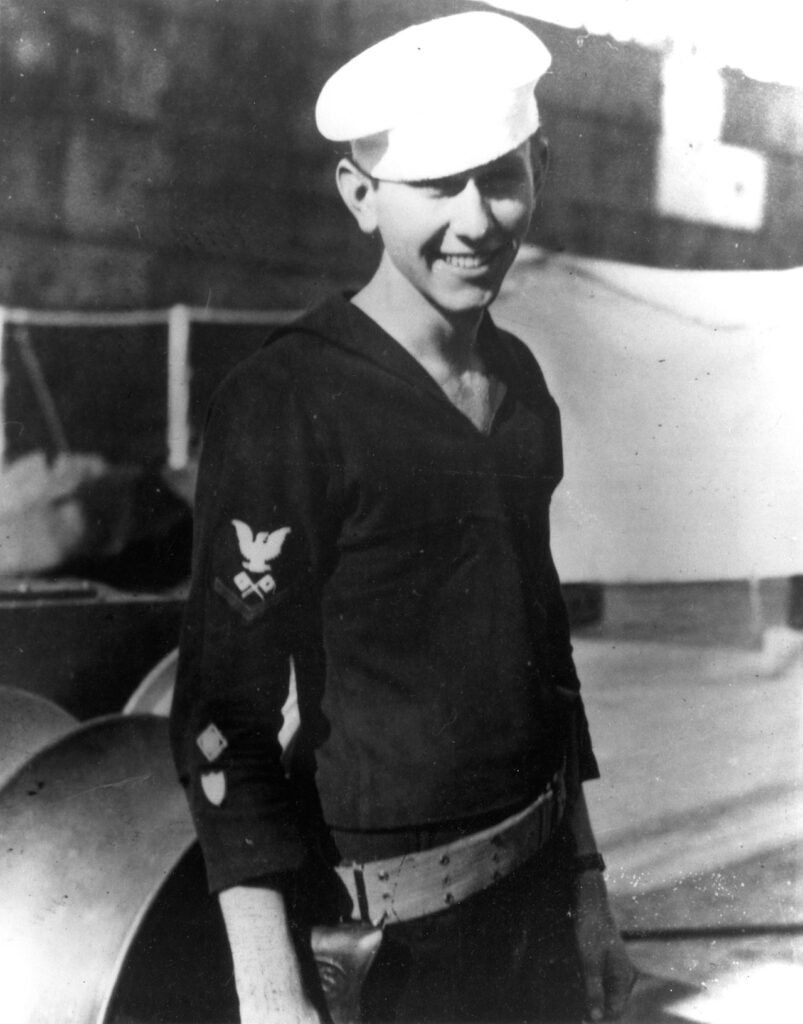
Munro initially volunteered for duty on board the USCG Cutter Spencer, where he served until 1941 and earned his Signalman 3rd Class rating. In June 1941, President Roosevelt directed the Coast Guard to man four large transports and serve in mixed crews onboard twenty-two naval ships. When word arrived that these ships needed Signalmen, Munro repeatedly requested and was finally granted permission to transfer to the USS Hunter Liggett (APA-14).
The “Lucky” Liggett was a 535 foot, 13,712 ton ship and was one of the largest attack transports in the Pacific. She carried nearly 700 Officers and men and thirty-five landing boats, including thirty-three LCVPs (Landing Craft, Vehicle, Personnel, or Higgin’s boats) and two LCMs (Landing Craft Mechanized). In April 1942, the Liggett sailed to Wellington, New Zealand, to prepare for a major campaign in the south Pacific.
As the task force gathered, Munro, now a Signalman First Class, was assigned to temporary duty on the staff of Commander, Transport Division Seventeen. During the preparations for the invasion, he was transferred from ship to ship, as his talents were needed. The task force rendezvoused at sea near the end of July, and on August 7, the Liggett led the other transports to their anchorage off Guadalcanal, serving as the amphibious task force command post until the Marines secured the beaches.
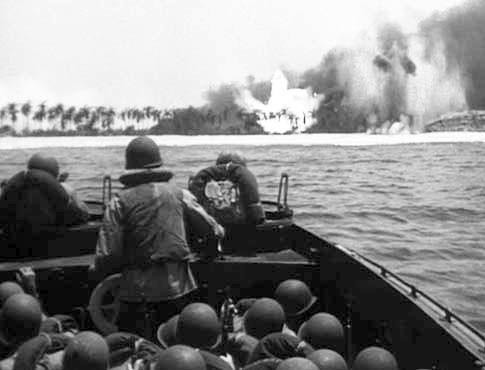
At the time of the invasion, Munro was attached to the staff of Rear Admiral Richmond Kelly Turner on board the smaller 9,600-ton attack transport USS McCawley (APA-4). He made the landing on Tulagi Island where fierce fighting lasted for several days. About two weeks later, Munro was sent twenty miles across the channel to Guadalcanal where the Marines had landed and had driven inland. One of the bloodiest and most decisive battles ensued, and the Americans quickly seized the island’s airfield.
After the initial landings at Guadalcanal, Munro and twenty-four other Coast Guard and Navy personnel were assigned to the newly-established base at Lunga Point. The base was commanded by CDR Dwight H. Dexter, USCG, who was in charge of all the small boat operations on Guadalcanal. Situated on the Lever Brothers coconut plantation, the base consisted of a small house with a newly constructed coconut tree signal tower, and Munro was assigned there because of his Signalman rating. The base served as the staging area for troop movements along the coast. To facilitate this movement, a pool of landing craft from the numerous transports lay there to expedite the transportation of supplies and men.
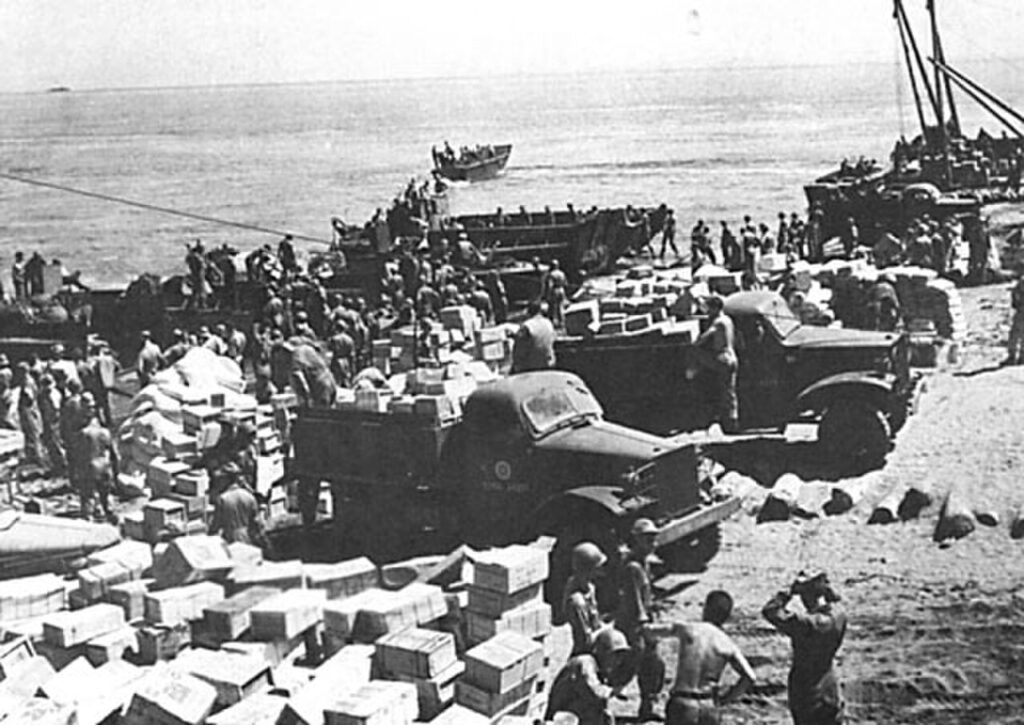
A month into the campaign, the Marines on the island were reinforced and decided to push beyond their defensive perimeter. They planned to advance west across the Matanikau River to prevent smaller Japanese units from combining and striking American positions in overwhelming numbers. For several days near the end of September, the Marines tried to cross the Matanikau River from the east and each time met tremendous resistance. On Sunday, Sept. 27, Marine LtCol Lewis B. “Chesty” Puller, commander of 1st Battalion, 7th Marines, 1st Marine Division, embarked three companies of his 7th Marines in landing craft to land west of the river, drive out the Japanese and establish a patrol base on the west side of the Matanikau.
Just two weeks short of his twenty-third birthday, Munro took charge of ten LCPs (Landing Craft Personnel) and LCTs (Landing Craft Tank, or tank lighters) from the landing craft contingent at the Lunga Point base that were dispatched to transport Puller’s men to a small cove west of Point Cruz. The destroyer USS Monssen initiated the assault shortly after noon with a covering barrage from her five-inch guns. 500 Marines, led by Maj. Ortho L. Rodgers, landed unopposed in two waves at 1 PM, then pushed inland and reorganized on a ridge about 500 yards from the beach.
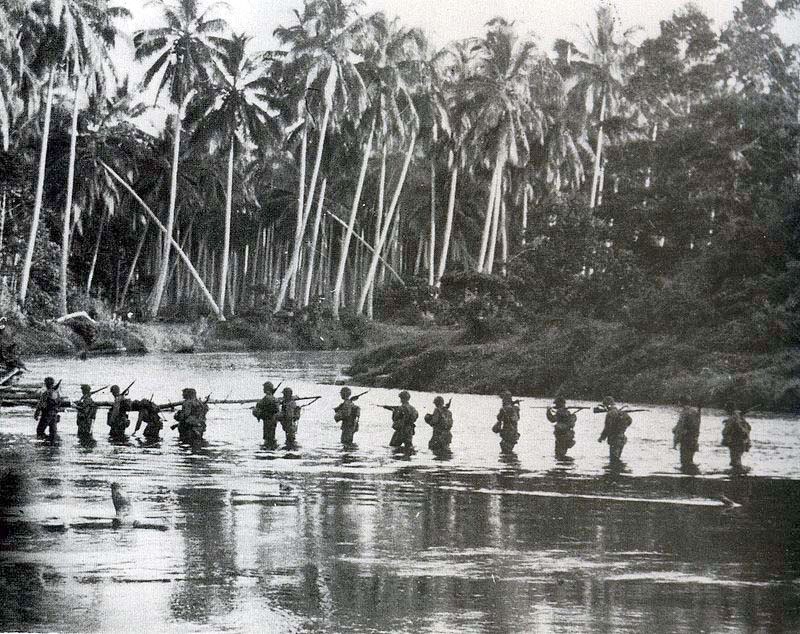
Unbeknownst to Maj. Rodgers’ Marines, a high-level Japanese air raid of 17 bombers struck Henderson Field as they were disembarking on the beach, interrupting the Marine’s communication net and preventing word of unexpectedly strong Japanese forces from being relayed to Puller from a party of Marine Raiders probing further up the west side of the Matanikau River. The air raid also forced the support ships, including the Monssen and its supporting firepower, to temporarily get underway and withdraw from the vicinity of the island, denying the crucial fire support the Marines would immediately need.
At approximately 1:50 PM, as they reached the ridge, an overwhelming Japanese force struck Puller’s Marines from west of the river. This catastrophic situation deteriorated even further when Maj. Rodgers was killed and one of the Company Commanders was wounded. The Marines were stranded with no fire support or communications, facing superior enemy numbers, and in imminent danger of being surrounded and annihilated.
After landing the Marines, Munro returned to Lunga Point with his landing craft. A single LCP manned by Coast Guard Petty Officer Ray Evans and Navy Coxswain Samuel B. Roberts remained behind to take off the immediate wounded, staying extremely close to the beach to expedite the process. Meanwhile, Japanese forces that had worked their way behind the Marine landing party suddenly fired a machine gun burst that hit the LCP, severing the rudder cable and disabling the boat’s steering controls. After jury-rigging the rudder, Roberts was struck by enemy fire and Evans managed to jam the controls to full ahead and sped back to Lunga Point Base. Unable to stop, the LCP ran onto the beach at 20 mph. Roberts later died but was posthumously awarded the Navy Cross.
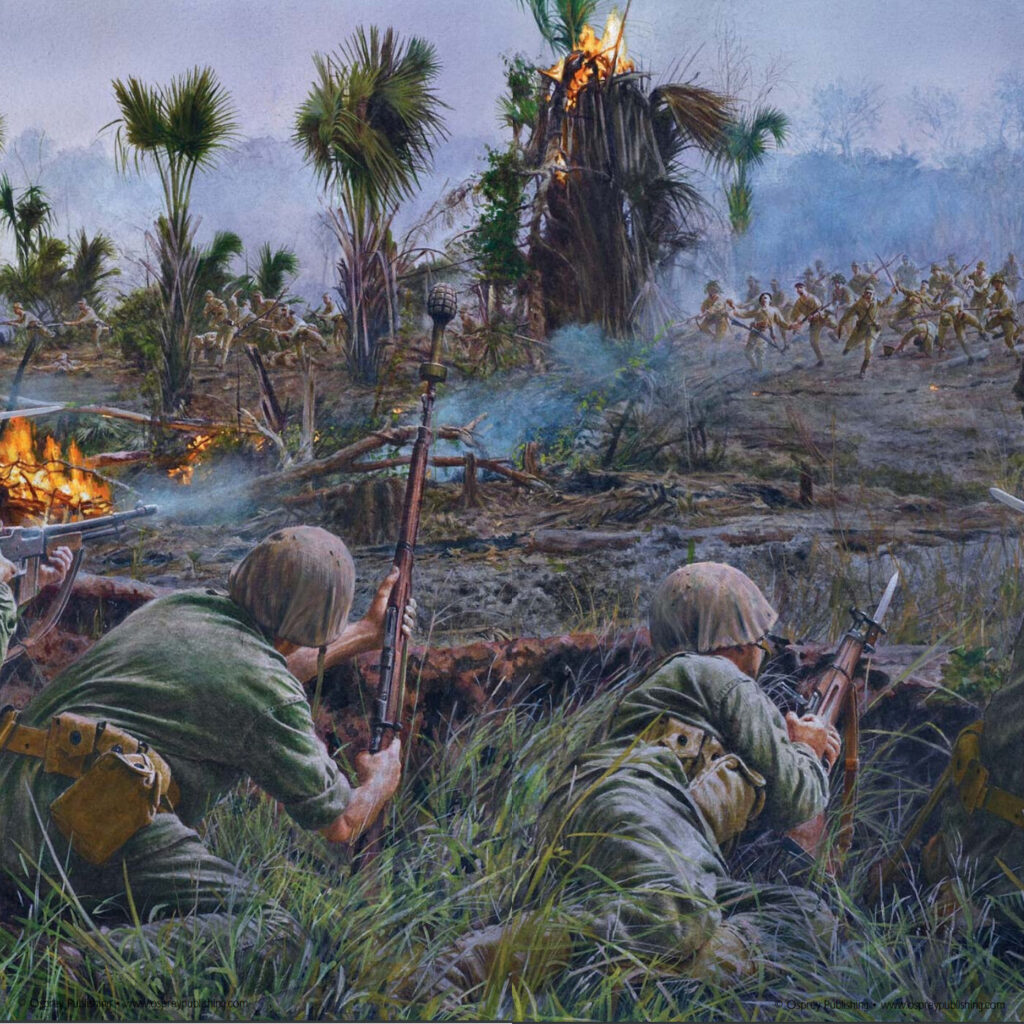
As the shot-up boat piloted by Evans arrived back at the Lunga Point base, the plight of the Marines was not known, since they had failed to take a radio and were unable to communicate their predicament, and the bombing raid had driven the destroyer Monssen out of visual range with the Marines. However, the enterprising Marines used their under-shirts to spell out the word “HELP” on a ridge not far from the beach, and “Cactus Air Force” pilot Second Lieutenant Dale Leslie, flying out of Henderson Field in a Douglas SBD “Dauntless” naval scout plane/dive bomber, spotted the message and passed it by radio to another Marine unit. Word quickly arrived that the Marines were in trouble and were being driven back toward the beach.
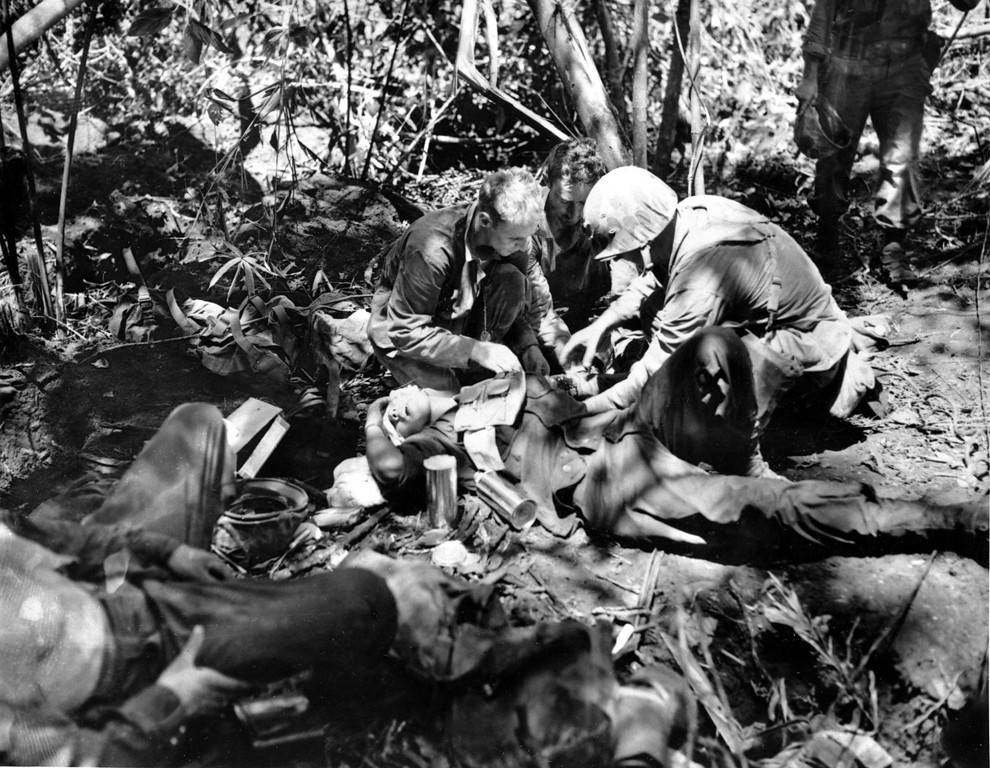
At 4 P.M., Lt. Col. Puller, realizing that his men were isolated and endangered, embarked on Monssen to personally direct the covering fire for the Marines who were desperately trying to reach the beach for extraction. Puller re-established communications with his surrounded Marines via visual signals and directed the Monssen to blast a path through the Japanese to provide a route for his surrounded Marines to return back to the beach.
The landing crafts had meanwhile been readied at Lunga Point. Again, virtually the same boats that had put the Marines on the beach were assembled to extract them. Douglas Munro, who had taken charge of the original landing, volunteered to lead the boats back to the beach. None of these boats were heavily armed or well-protected. For example, Munro’s Higgins boat had a plywood hull, it was slow, vulnerable to small arms fire, and was armed only with two air-cooled .30 caliber Lewis machine guns.
As Munro led the boats ashore, the Japanese fired on the small craft from Point Cruz, the ridges abandoned by the Marines, and from positions east of the beach. This intense fire from three strong interlocking positions disrupted the landing and caused a number of casualties among the virtually defenseless crews in the boats. Despite the intense fire, Munro led the boats ashore in waves of two or three at a time to pick up the Marines. Munro and Evans provided covering fire from their exposed position on the beach as the Japanese pressed ever closer to the beach, making the withdrawal increasingly dangerous with each passing second.

The returning Monssen, along with Leslie’s “Dauntless” dive bomber, provided additional cover fire for the withdrawing Marines. As the Marines arrived on the beach to embark on the landing craft, the Japanese maintained a murderous and withering fire from the ridges abandoned by the Marines, just 500 yards away, and the last group with their twenty-five wounded were in danger of being cut down. Munro quickly identified the deadly situation and unhesitatingly maneuvered his boat between the enemy and the final group of withdrawing Marines to protect the remnants of the battalion. With no regard to his own personal safety and exposed to the enemy’s deadly fire, Munro successfully provided cover and enabled the last remaining Marines to escape the deadly trap.
Munro and Evans Steered Their LCP Offshore
With all the Marines safely in the dangerously-overloaded small craft, Munro and Evans steered their LCP offshore. As Munro and Evans passed towards Point Cruz they noticed an LCT full of Marines grounded on the beach. Munro steered his landing craft to assist the disabled LCT and directed another tank lighter to pull it off. Twenty minutes later, the craft was free and heading out to sea. Before Munro and Evans could get very far from shore, the Japanese had set up a machine gun and began firing at the boats. Evans saw the incoming fire and shouted a warning to Munro, but the roar of the boat’s engine prevented Munro from hearing him, and a single bullet hit him in the base of the skull. Munro remained conscious long enough to say only four words, “Did they get off?” before dying.
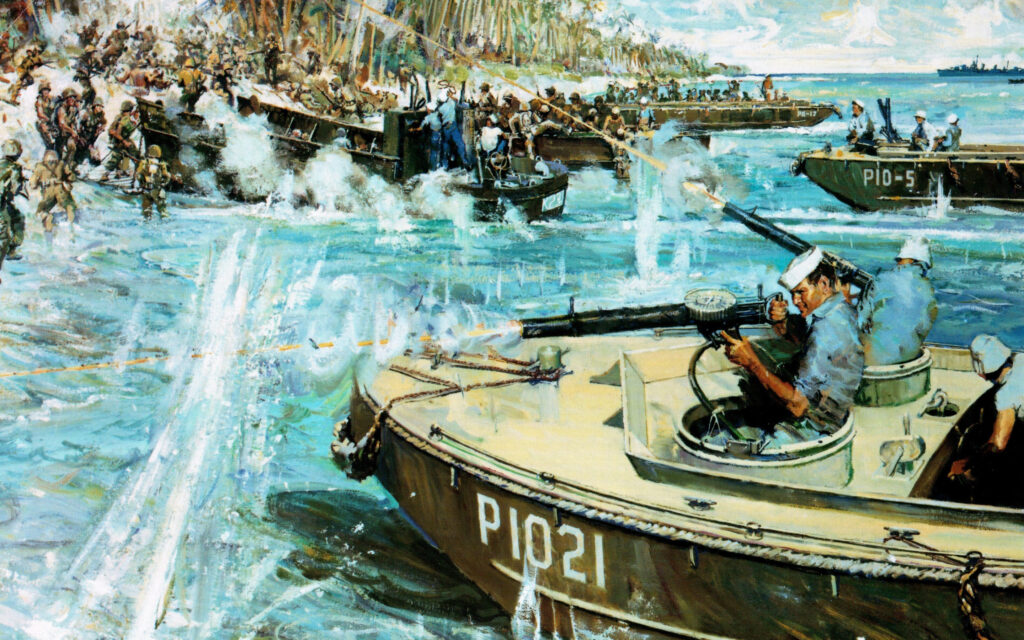
Douglas Munro was Posthumously Awarded the Medal of Honor
Due to his extraordinary heroism, outstanding leadership and gallantry, Signalman First Class Douglas Munro was posthumously awarded the Medal of Honor, the only coast guardsman to receive such an honor. The U.S. Coast Guard has named two of their cutters in his honor, the high-endurance cutter USCGC Munro (WHEC-724), and the National Security Legend-class cutter USCGC Munro (WMSL-755), while the Navy has named a destroyer escort in his honor, the USS Douglas A. Munro (DE-422). The Douglas A. Munro Inspirational Leadership Award is annually awarded to the Coast Guard enlisted member who has demonstrated outstanding leadership and professional competence to the extent of their rank and rate.
Raymond Evans was Awarded the Navy Cross for His Actions on Guadalcanal
Raymond Evans, who remained in the Coast Guard, retired as a Commander. He was awarded the Navy Cross for his actions on Guadalcanal. He died on June 7, 2013, at the age of 92. The USCGC Raymond Evans (WPC-1110) is named in his honor. The CDR Ray Evans Outstanding Coxswain Trophy is a prestigious annual award that recognizes a Coast Guard coxswain who demonstrates exceptional boat handling skills and leadership.
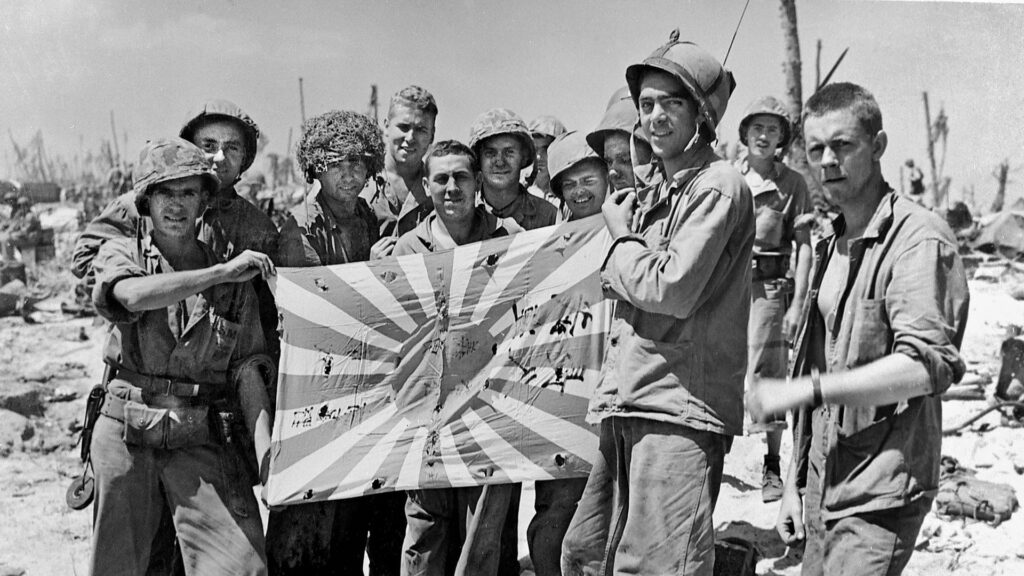
In honor of Samuel B. Roberts, the US Navy named three ships after him. The destroyer escort USS Samuel B. Roberts (DE-413), commissioned in April 1944, fought in the Battle of Leyte Gulf of October 1944 and was sunk by the Imperial Japanese Navy in the Battle off Samar on October 25, 1944. The USS Samuel B. Roberts (DD-823), a Gearing-class destroyer, was the second ship of the United States Navy to be named for Samuel B. Roberts. In August 1970, the ship was ruled unfit for further service and was sunk as a target in the Atlantic Ocean 195 nautical miles north of Puerto Rico on November 14, 1971. The third USS Samuel B. Roberts (FFG-58), is an Oliver Hazard Perry-class guided-missile frigate, commissioned in 1986 and decommissioned on May 22, 2015. When it struck an Iranian mine in the Persian Gulf in 1988 and was in danger of sinking, its crewmen who were engaged in damage control passed around and touched a plaque commemorating the first ship.
The Solomon Islands Campaign cost the Allies approximately 7,100 men, 29 ships and 615 aircraft. The Japanese lost 31,000 men, 38 ships and 683 aircraft. Over the next two and a half years, U.S. forces captured the Gilbert Islands (Tarawa and Makin), the Marshall Islands (Kwajalein and Eniwetok), the Mariana Islands (Saipan, Guam, and Tinian), Iwo Jima and Okinawa. With each island reclaimed from the Japanese, the U.S. moved closer to Japan. Growing superiority at sea and in the air, as well as in the number of fighting men, gave the U.S. increasing advantages. Nonetheless, wherever U.S. forces met Japanese defenders, the enemy fought long and hard before being defeated.
Read About Other Profiles in Courage
If you enjoyed learning about the heroes of the Coast Guard: Munro and Evans, we invite you to read about other profiles in courage on our blog. You will also find military book reviews, veterans’ service reflections, famous military units and more on the TogetherWeServed.com blog. If you are a veteran, find your military buddies, view historic boot camp photos, build a printable military service plaque, and more on TogetherWeServed.com today.

The narrative talks about Monro operating a Higgins boat which is the LCVP a 36 ft landing craft with a bow ramp. Munro actually performed his heroics in a LCP smaller with a blunt bow designed to only carry personnel